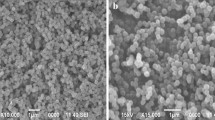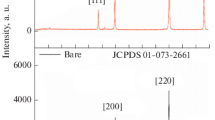Abstract
A facile and acceptable way for arrangement of non-wetting ultra-hydrophobic silica coatings is proposed in this work. The X80 steel samples with the dimension of 10 × 10 × 2 mm were used as the base metal. Commercially silica nanoparticles were modified using alkoxide organosilane as an active modifying agent. The ultra-hydrophobic silica coatings with a water contact angle of 142° were achieved (ultra-high degree of contact angle). The prepared silica coatings exhibit ultra-hydrophobicity and excellent corrosion behaviors under 3.5 wt% NaCl immersion testing conditions, which surfaces with 2.0% and 2.5% of hydrophobic silica specimens show a low corrosion potential and current, significantly. The corrosion resistance of the samples was evaluated by the electrochemical impedance spectroscopy technique also the microstructure, and surface topography of the samples was evaluated with scanning electron microscopy and Fourier transform infrared, respectively. This coating method is expected such a convincing process technology against fabricating self-cleaning coatings for the encouraging industrial implementation.













Similar content being viewed by others
References
Albert E, Cotolan N, Nagy N, Sáfrán G, Szabó G, Mureşan L-M, Hórvölgyi Z (2015) Mesoporous silica coatings with improved corrosion protection properties. Microporous Mesoporous Mater 206:102–113
Aramaki K, Shimura T (2004) Preparation of a one-dimensional polymer film on passivated iron by modification of a carboxylate ion self-assembled monolayer with octyltriethoxysilane for preventing passive film breakdown. Corros Sci 46:2533–2548
Avendano-Castro C, Galvan-Martinez R, Contreras A, Salazar M, Orozco-Cruz R, Martinez E, Torres-Sanchez R (2009) Corrosion kinetics of pipeline carbon steel weld immersed in aqueous solution containing H2S. Corros Eng Sci Technol 44:149–156
Buck BJ, Brock AL, Johnson WH, Ulery AL (2004) Corrosion of depleted uranium in an arid environment: soil-geomorphology, SEM/EDS, XRD, and electron microprobe analyses. Soil Sediment Contam 13:545–561
Busalmen JP, Vazquez M, De Sanchez S (2002) New evidences on the catalase mechanism of microbial corrosion. Electrochim Acta 47:1857–1865
Chen MJ, Dong G, Jakobsen RA, Bai Y (2000) Assessment of pipeline girth weld defects. In: The Tenth International Offshore and Polar Engineering Conference. International Society of Offshore and Polar Engineers
Cole IS, Marney D (2012) The science of pipe corrosion: A review of the literature on the corrosion of ferrous metals in soils. Corros Sci 56:5–16
De Reus H, Hendriksen L, Wilms M, Al-Habsi YN, Durnie W (2005) Gough M Test methodologies and field verification of corrosion inhibitors to address under deposit corrosion in oil and gas production systems. In: Corrosion, NACE International
Durnie W, Gough M, De Reus H (2005) Development of corrosion inhibitors to address under deposit corrosion in oil and gas production systems. In: Corrosion. NACE International
Gao M, Pang X, Gao K (2011) The growth mechanism of CO2 corrosion product films. Corros Sci 53:557–568
Garcia S, Markley T, Mol J, Hughes A (2013) Unravelling the corrosion inhibition mechanisms of bi-functional inhibitors by EIS and SEM–EDS. Corros Sci 69:346–358
Guo Y, Wang H, Zeng L (2015) SiO2 aerogels prepared by ambient pressure drying with ternary azeotropes as components of pore fluid. J Non Cryst Solids 428:1–5
Hamdy AS, Butt D (2006) Environmentally compliant silica conversion coatings prepared by sol–gel method for aluminum alloys. Surf Coat Technol 201:401–407
He B, Lu C-H, Han P-J, Bai X-H (2016) Short-term electrochemical corrosion behavior of pipeline steel in saline sandy environments. Eng Fail Anal 59:410–418xt
Ilman M (2014) Analysis of internal corrosion in subsea oil pipeline. Case Stud Eng Fail Anal 2:1–8
Ingo GM, Balbi S, De Caro T, Fragalà I, Angelini E, Bultrini G (2006) Combined use of SEM–EDS, OM and XRD for the characterization of corrosion products grown on silver roman coins. Appl Phys A 83:493–497
Islam M, Azhar MR, Fredj N, Burleigh TD, Oloyede OR, Almajid AA, Shah SI (2015) Influence of SiO2 nanoparticles on hardness and corrosion resistance of electroless Ni–P coatings. Surf Coat Technol 261:141–148
Iverson WP (1987) Microbial corrosion of metals. In: Advances in applied microbiology, vol 32. Elsevier, The Amsterdam, pp 1–36
Jakupi P, Wang F, Noël J, Shoesmith D (2011) Corrosion product analysis on crevice corroded alloy-22 specimens. Corros Sci 53:1670–1679
Jothi KJ, Palanivelu K (2013) Synergistic effect of silane modified nanocomposites for active corrosion protection. Ceram Int 39:7619–7625
Kessman AJ, Ramji K, Morris NJ, Cairns DR (2009) Zirconia sol–gel coatings on alumina–silica refractory material for improved corrosion resistance. Surf Coat Technol 204:477–483
Kim B, Kang J, Lee K, Son J, Ko M (2007) Physical properties of low-k films based on the co-condensation of methyltrimethoxysilane with a bridged silsesquioxane. J Mat Sci 42:4591–4602
Krishnamurthy A, Gadhamshetty V, Mukherjee R, Chen Z, Ren W, Cheng H, Koratkar N (2013) Passivation of microbial corrosion using a graphene coating. Carbon 56:45–49
Kumar AM, Gasem ZM (2015) In situ electrochemical synthesis of polyaniline/f-MWCNT nanocomposite coatings on mild steel for corrosion protection in 3.5% NaCl solution. Prog Org Coat 78:387–394
Lee C-K (2012) Comparative corrosion resistance of electroless Ni-P/nano-TiO2 and Ni-P/nano-CNT composite coatings on 5083 aluminum alloy. Int J Electrochem Sci 7:12941–12954
Lister D, Davidson R, McAlpine E (1987) The mechanism and kinetics of corrosion product release from stainless steel in lithiated high temperature water. Corros Sci 27:113–140
Liu Y, Chen X, Xin J (2006) Super-hydrophobic surfaces from a simple coating method: a bionic nanoengineering approach. Nanotechnology 17:3259
Maier B, Frankel G (2011) Pitting corrosion of silica-coated type 304 stainless steel under thin electrolyte layers. Corrosion 67:035004-035001-035004-035010
Malekmohammadi F, Rouhaghdam AS, Shahrabi T (2011) Effect of heat treatment on corrosion properties of mixed sol–gel silica–titania coating. J Non Cryst Solids 357:1141–1146
Martinez S, Grozdanić V, Ivanković A (2012) SEM/EDS analysis of corrosion products from the interior of a crude oil pipeline. Zaštita Materijala 53:191–194
Mora LV, Naik S, Paul S, Dawson R, Neville A, Barker R (2017) Influence of silica nanoparticles on corrosion resistance of sol–gel based coatings on mild steel. Surf Coat Technol 324:368–375
Mora LV et al (2018) Impact of silica nanoparticles on the morphology and mechanical properties of sol–gel derived coatings. Surf Coat Technol 342:48–56
Nešić S (2007) Key issues related to modelling of internal corrosion of oil and gas pipelines—a review. Corros Sci 49:4308–4338
Nozawa K, Nishihara H, Aramaki K (1997) Chemical modification of alkanethiol monolayers for protecting iron against corrosion. Corros Sci 39:1625–1639
Papavinasam S, Doiron A, Panneerselvam T, Revie R (2007) Effect of hydrocarbons on the internal corrosion of oil and gas pipelines. Corrosion 63:704–712
Papavinasam S, Doiron A, Revie RW (2010) Model to predict internal pitting corrosion of oil and gas pipelines. Corrosion 66:035006-035006-035011
Peng C-W et al (2013) Nano-casting technique to prepare polyaniline surface with biomimetic superhydrophobic structures for anticorrosion application. Electrochim Acta 95:192–199
Pourhashem S, Vaezi MR, Rashidi A (2017) Investigating the effect of SiO2-graphene oxide hybrid as inorganic nanofiller on corrosion protection properties of epoxy coatings. Surf Coat Technol 311:282–294
Ramezanzadeh B, Haeri Z, Ramezanzadeh M (2016) A facile route of making silica nanoparticles-covered graphene oxide nanohybrids (SiO2-GO); fabrication of SiO2-GO/epoxy composite coating with superior barrier and corrosion protection performance. Chem Eng J 303:511–528
Shang HM, Wang Y, Takahashi K, Cao GZ, Li D, Xia Y (2005) Nanostructured superhydrophobic surfaces. J Mat Sci 40:3587–3591
Sridhar N, Dunn D, Anderko A, Lencka M, Schutt H (2001) Effects of water and gas compositions on the internal corrosion of gas pipelines—modeling and experimental studies. Corrosion 57:221–235
Tada E, Frankel G (2007) Effects of particulate silica coatings on localized corrosion behavior of AISI 304SS under atmospheric corrosion conditions. J Electrochem Soc 154:C318–C325
Tan Y, Fwu Y, Bhardwaj K (2011) Electrochemical evaluation of under-deposit corrosion and its inhibition using the wire beam electrode method. Corros Sci 53:1254–1261
Trdan U, Grum J (2014) SEM/EDS characterization of laser shock peening effect on localized corrosion of Al alloy in a near natural chloride environment. Corros Sci 82:328–338
Vargas-Arista B, Albiter A, García-Vázquez F, Mendoza-Camargo Ó, Hallen JM (2014) Effect of natural aging on the microstructural regions, mechanical properties, corrosion resistance and fracture in welded joints on API5L X52 steel pipeline. Rev Metal. e024
Venault A, Jumao-as-Leyba AJ, Chou F-C, Bouyer D, Lin I-J, Wei T-C, Chang Y (2016) Design of near-superhydrophobic/superoleophilic PVDF and PP membranes for the gravity-driven breaking of water-in-oil emulsions. J Taiwan Inst Chem Eng 65:459–471
Venzlaff H, Enning D, Srinivasan J, Mayrhofer KJ, Hassel AW, Widdel F, Stratmann M (2013) Accelerated cathodic reaction in microbial corrosion of iron due to direct electron uptake by sulfate-reducing bacteria. Corros Sci 66:88–96
Vera JR, Daniels D, Achour MH (2012) Under deposit corrosion (UDC) in the oil and gas industry: a review of mechanisms, testing and mitigation. In: Corrosion. NACE International
Wang H, Zhang C, Zhou B, Zhang Z, Shen J, Du A (2020) Hydrophobic silica nanorod arrays vertically grown on melamine foams for oil/water separation. ACS Applied Nano Mat
Wei L, Pang X, Liu C, Gao K (2015) Formation mechanism and protective property of corrosion product scale on X70 steel under supercritical CO2 environment. Corros Sci 100:404–420
Yu X, Wu X, Si Y, Wang X, Yu J, Ding B (2019) Waterproof and breathable electrospun nanofibrous membranes. Macromol Rapid Commun 40:1800931
Zhang G, Cheng Y (2009) Micro-electrochemical characterization of corrosion of welded X70 pipeline steel in near-neutral pH solution. Corros Sci 51:1714–1724
Zhang Z, Huo F, Zhang X, Guo D (2012a) Fabrication and size prediction of crystalline nanoparticles of silicon induced by nanogrinding with ultrafine diamond grits. Scripta Mater 67:657–660
Zhang Z, Song Y, Xu C, Guo D (2012b) A novel model for undeformed nanometer chips of soft-brittle HgCdTe films induced by ultrafine diamond grits. Scripta Mater 67:197–200
Zhang Z, Huo Y, Guo D (2013) A model for nanogrinding based on direct evidence of ground chips of silicon wafers. Sci China Technol Sci 56:2099–2108
Zhang Z, Guo D, Wang B, Kang R, Zhang B (2015a) A novel approach of high speed scratching on silicon wafers at nanoscale depths of cut. Sci Rep 5:16395
Zhang Z, Wang B, Kang R, Zhang B, Guo D (2015b) Changes in surface layer of silicon wafers from diamond scratching. Cirp Ann 64:349–352
Zhang Z, Wang B, Zhou P, Guo D, Kang R, Zhang B (2016a) A novel approach of chemical mechanical polishing using environment-friendly slurry for mercury cadmium telluride semiconductors. Sci Rep 6:22466
Zhang Z, Wang B, Zhou P, Kang R, Zhang B, Guo D (2016b) A novel approach of chemical mechanical polishing for cadmium zinc telluride wafers. Sci Rep 6:26891
Zhang Z, Cui J, Wang B, Wang Z, Kang R, Guo D (2017a) A novel approach of mechanical chemical grinding. J Alloys Compd 726:514–524
Zhang Z, Du Y, Wang B, Wang Z, Kang R, Guo D (2017b) Nanoscale wear layers on silicon wafers induced by mechanical chemical grinding. Tribol Lett 65:132
Zhang Z et al (2017c) A novel approach of high-performance grinding using developed diamond wheels. Intern J Adv Manuf Technol 91:3315–3326
Zhang Z, Shi Z, Du Y, Yu Z, Guo L, Guo D (2018) A novel approach of chemical mechanical polishing for a titanium alloy using an environment-friendly slurry. Appl Surf Sci 427:409–415
Zhang Z, Cui J, Zhang J, Liu D, Yu Z, Guo D (2019) Environment friendly chemical mechanical polishing of copper. Appl Surf Sci 467:5–11
Zhang Z, Liao L, Wang X, Xie W, Guo D (2020) Development of a novel chemical mechanical polishing slurry and its polishing mechanisms on a nickel alloy. Appl Surf Sci 506:144670
Zhu J, Tian Y, Liu X, Yang C (2019) Lithography-induced hydrophobic surfaces of silicon wafers with excellent anisotropic wetting properties. Microsyst Technol 25:735–745
Author information
Authors and Affiliations
Corresponding author
Ethics declarations
Conflict of interest
The authors declare no conflict of interest.
Additional information
Publisher's Note
Springer Nature remains neutral with regard to jurisdictional claims in published maps and institutional affiliations.
Rights and permissions
About this article
Cite this article
Tangsee, S., Lashari, N. Facile synthesis of nano silica-based coating on API5L-x80 steel to achieve ultra non-wetting surface and its corrosion resistance. Appl Nanosci 10, 4103–4113 (2020). https://doi.org/10.1007/s13204-020-01522-8
Received:
Accepted:
Published:
Issue Date:
DOI: https://doi.org/10.1007/s13204-020-01522-8




